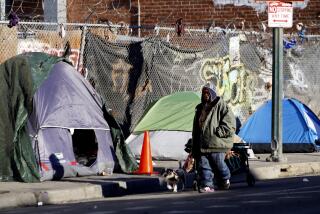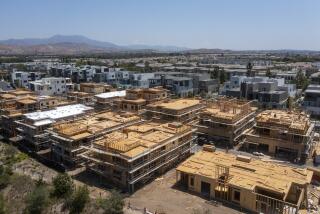Mature Form Huge Home Market
WASHINGTON — The torrid housing market includes 51 million mature Americans, mostly married and without dependents.
They are becoming increasingly significant in the home-buying market because they have a median annual income in excess of $38,000, own their present house with little or no mortgage and are demonstrating an increasing tendency to move into a new or different home. It’s generally smaller and in a neighborhood near where they previously lived. Also, it’s in close, but not too close, proximity to children and grandchildren.
Statistics gathered by the National Assn. of Realtors indicate that builders are more and more aware and responsive to mature Americans who are now perceived as “the fastest growing and most financially well-off segment of the American population.”
Federal statistics tell us that about 22 million persons aged 55 to 64 follow pre-retirement life styles much like persons in their mid-40s, rather than the slower-lane pattern of persons in their middle 60s. These “youngsters” of the mature market are described by realtors as “older.”
Another segment of the mature housing market includes persons 65 to 74, who are labeled “elderly.” They number about 17 million. These folks are in the first, active stage of retirement living. They tend to be ardent golfers, dedicated bridge players and consistent travelers. Most of these well-heeled retirees make it to a southern or southwestern climate for at least a few weeks--and sometimes all through the winter season.
Mature Americans in the housing market include the “aged.” Nine million strong, they are in the 75 to 85 age bracket and favor a slightly slower life pace than do their junior seniors. But I know at least one 80-year-old who swims at least a quarter-mile three or four days a week--the kind of exercise advocated for older persons who are trying to avoid heart attacks.
The so-called “very old” are 85 and over, and the category includes 3 million persons.
Housing and demographic experts foresee the mature housing market increasing 9% over the next 10 years to about 56 million, with the “very old” segment increasing the most in terms of percentage. Conversely, the size of the “older” population still will decline nearly 6%, but nevertheless still make up the largest percentage (about 38%) of the mature market.
Interviews with senior Americans confirm that most members of this rapidly growing mature market do not want to be forced to become part of their children’s households. Nor do they favor “granny flats” or “in-law suites.” They like an independent living style. Yet, they are also mightily concerned about good security in their neighborhood, convenience to medical and nursing care and good services.
Therefore, realtors expect a future boom in multifamily rental housing and condominium and cooperative communities. Tomorrow’s communities for mature Americans may be called “ghettos of the aging and aged,” but it is likely that their environment will include restaurants, cultural centers, nursing-care facilities and special health care arrangements and general hospitals in the area.
While both the young and slightly older segments of the mature market strongly favor detached single-family houses, there is some evidence that America will be seeing a “coming wave of specialized competitive housing communities.”
In the Washington area and other populous areas of the nation, the multi-level care community is becoming more pervasive. One such project offers town-house cottages and low-rise apartments with a choose-your-own-mix of services. A standard arrangement includes one meal a day, laundry, housekeeping and transportation services--plus on-site medical assistance, game rooms and varied cultural activities. Another package includes three meals daily, dressing and personalized services--all with a price tag.
No matter any criticism directed at adult communities that are havens for the gray-haired grandparents and great-grandparents, it is becoming increasingly evident that residents of those communities are neither conformist nor monolithic. Mostly, they just like growing older actively among their peers in a life style they can afford.
More to Read
Inside the business of entertainment
The Wide Shot brings you news, analysis and insights on everything from streaming wars to production — and what it all means for the future.
You may occasionally receive promotional content from the Los Angeles Times.










